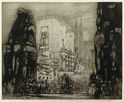
19th, 20th & 21st Century Fine Prints
707-546-7352 · fax 707-546-7924 · web: www.annexgalleries.com · email: artannex@aol.com
William Walcot Biography
William Walcot
British
1874–1943
Biography
William Walcot, etcher, architect, and graphic artist was born in Lustdorf, near Odessa in the Russian Empire on March 10,1874. Though most well known for his architectural work, Walcot's printmaking work is heralded for its use of contemporary or imagined cities and structures in classical antiquity. From a mixed Scottish-Russian family, the British artist lived throughout Western Europe and South Africa for most of his childhood, returning to Russia at age 17 to study art and architecture under Leon Benois at the Imperial Academy of Arts in Saint Petersburg. After some time spent studying in Paris, the artist pursued a career as an architect in Moscow for only six years; however, his exclusively Art Nouveau style made its mark in this time, with his renowned designs for the Metropol Hotel, Yakunchikova House, and Gutheil House. Walcot also created the famous and ever-present Lady's Head keystone, included in most of his structures.
Walcot's work as a graphic artist and printmaker soon followed. He moved to London in 1906, employed as an architectural draughtsman for the South African architect Eustace Frere. He began exhibiting his work at the Royal Academy's summer exhibitions, and was sponsored by the Fine Art Society to travel Venice and Rome. In 1919 a folio was published of his prints and paintings, titled The Architectural Watercolors and Etchings of William Walcot, to much acclaim. His depictions of reconstructed ancient Greek, Egyptian, Roman, and Babylonian structures were unique in that no other artist of the time had accomplished such visions in so elegant a manner. By the 1930s Walcot had become possibly the most prominent draughtsman in Europe.
Walcot was elected to the Royal Society of British Artists in 1913; was an associate of the Royal Society of Painter-Etchers and Engravers in 1916; elected a Fellow of the RIBA in 1922; and was an associate of the British School at Rome. However, despite his many successes, the onset of World War II ruined his firm and, in 1943, Walcot committed suicide. Despite his tragic end, his worls continued to be greatly regarded and are still exhibited to this day. His palette is preserved at the Royal Institute of British Architects and a major retrospective was held at the Fine Arts Society in 1974.
William Walcot died on May 21, 1943 in Hurstpierpoint, Sussex, UK.




